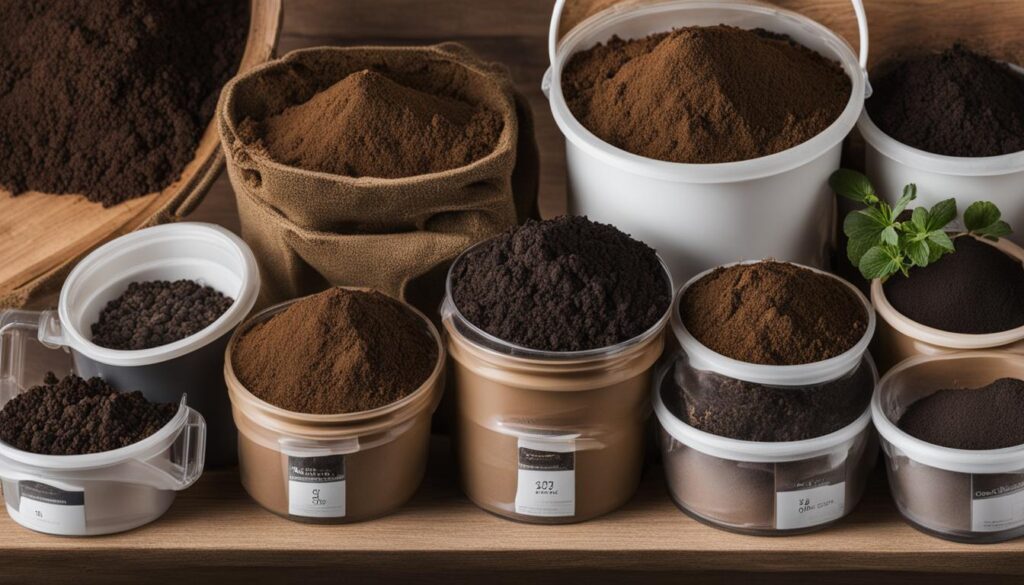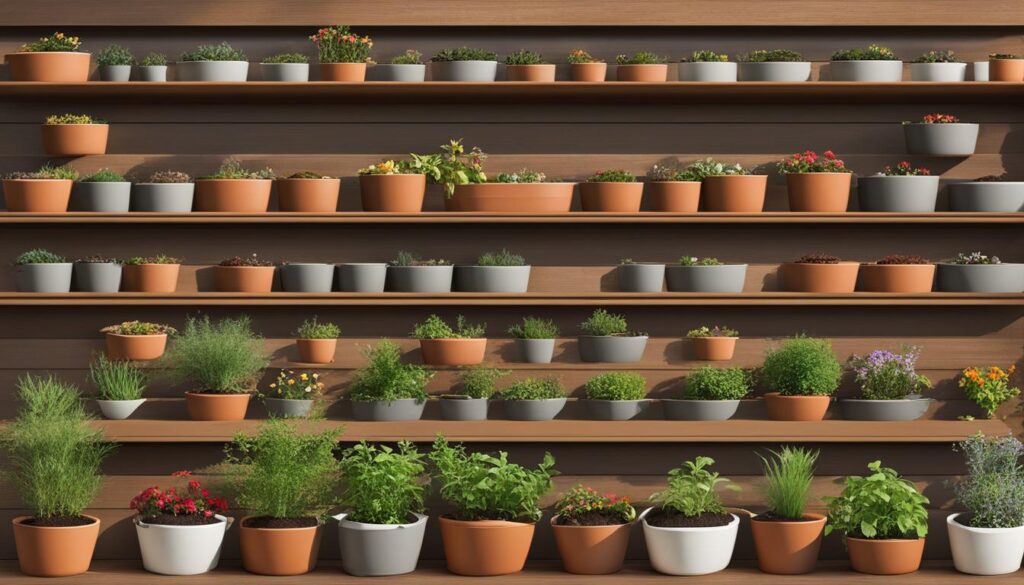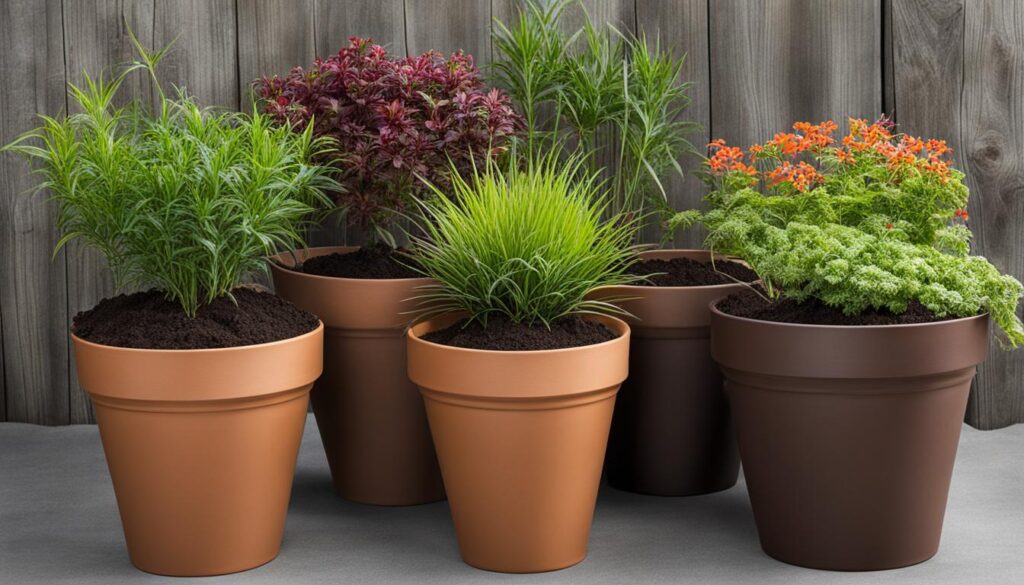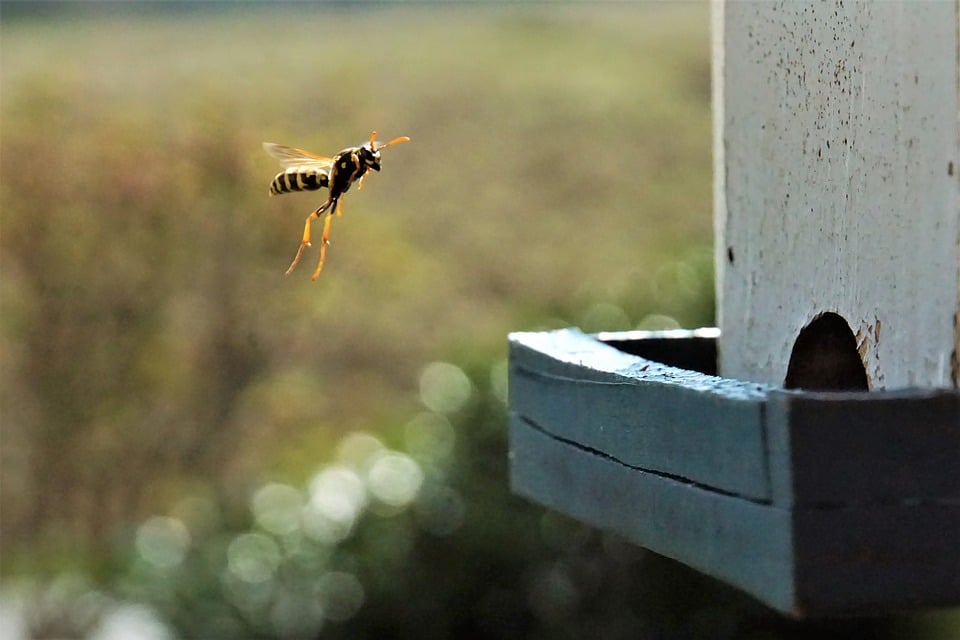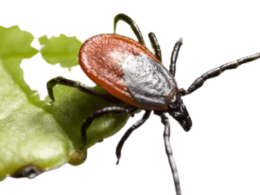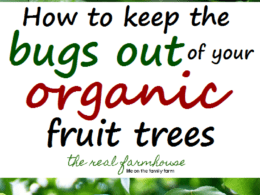When gardening in containers, it is important to fill each pot with high-quality potting soil to provide the best growing environment for your plants. The amount of soil you will need for a 16-inch pot can vary depending on the type of pot and the desired level of soil.
According to the first source, a 16-inch pot can hold approximately 12 dry quarts of potting soil. However, it is recommended to consider a 15-20% increase in soil quantity to account for soil compression and any additional soil needed for transplanting plants.
Key Takeaways
- Use high-quality potting soil for container gardening in a 16-inch pot.
- A 16-inch pot can hold around 12 dry quarts of potting soil.
- Consider a 15-20% increase in soil quantity to account for soil compression and transplanting.
- Measure the pot’s volume and refer to tables for more accurate estimations.
- Store leftover soil in a dry place for future use.
Determining Soil Volume for Different Pot Sizes
When it comes to gardening in containers, understanding the appropriate soil volume for different pot sizes is key. This knowledge ensures that your plants have enough space to grow and thrive. While the soil volume may vary depending on factors such as compression and existing soil, having a general guideline can be helpful.
According to a comprehensive table provided by the first source, a 16-inch pot typically requires approximately 12 dry quarts of soil. However, it’s important to remember that these numbers are approximate and may vary depending on various factors. The density of the potting mix, the presence of existing soil around the plant’s roots, and the level of soil compression can all influence the actual soil volume needed.
In addition to the first source, the second source offers further insights. Their table indicates that a 16-inch pot generally requires around 1.5 cubic feet of soil. This measurement provides an alternative perspective on estimating soil quantity for pots of different sizes.
Remember that these figures are guidelines and may not be precise measurements for every scenario. Consider the specific needs of your plants and adjust the soil volume accordingly.
Having a general understanding of the soil volume required for different pot sizes can help you plan your gardening projects more effectively. Consider the tables provided by reputable sources, but also take into account the unique factors that may affect soil quantity. By doing so, you’ll be able to provide your plants with the optimal growing environment and set them up for success.
Factors to Consider When Estimating Soil Quantity
When determining the amount of soil needed for a 16-inch pot, there are several factors that should be taken into consideration to ensure accuracy. One important factor is soil compression. As you moisten the soil and press it into the pot, it can take up more space than when it is dry. This can result in a 15-20% increase in the quantity of dry soil needed to fill the pot.
Another factor to consider is the transplanting of plants. When you move a plant from one pot to another, some of the soil will be displaced or moved around the roots. This can affect the final volume of soil required for the 16-inch pot.
Additionally, the type of potting mix you use can also impact the quantity of soil needed. Different potting mixes have varying densities, which means they can require different quantities to fill the same size pot. It is important to consider the specific potting mix you are using when estimating soil quantity.
Summary:
- Soil compression, when moistened and pressed into the pot, can result in a 15-20% increase in the quantity of dry soil needed.
- Transplanting plants can cause some soil to be moved around the roots, affecting the final volume of soil required.
- The type of potting mix used can have varying densities, requiring different quantities of soil to fill the same size pot.
By considering these factors, you can more accurately estimate the quantity of soil needed for a 16-inch pot, ensuring optimal growing conditions for your plants.
Tips for Estimating Soil Quantity
When it comes to estimating the right amount of soil for your 16-inch pot, there are a few helpful tips that can guide you in the process. Consider these suggestions to ensure you have enough soil for your container gardening needs:
- Measure your pot’s volume: To accurately estimate the soil quantity needed, measure the volume of your 16-inch pot. This can be done by filling the pot with water and then pouring the water into a measuring container. This will give you an idea of the pot’s capacity and help you determine the appropriate amount of soil.
- Refer to reliable sources: Utilize the tables provided by reliable sources to get an approximate soil volume for your pot size. These tables take into account factors such as pot size, soil compression, and transplanting to give you a better estimation of the required soil quantity.
- Take notes: Keep track of the soil quantities used in your own pots. This will help you make more accurate estimations in the future and ensure you have enough soil on hand for your gardening projects.
- Store leftover soil: If you have any leftover soil after potting your plants, make sure to store it properly for future use. Place the soil in a clean plastic tub or garbage can, and store it in a dry place to prevent moisture and mold growth.
By following these tips, you can estimate the right amount of soil for your 16-inch pot and provide optimal growing conditions for your plants. Remember, it’s always better to have a little extra soil on hand than to run out during the potting process.
Taking the guesswork out of soil volume
“Measuring the pot’s volume and referring to reliable sources can help you estimate the required soil quantity more accurately.”
Estimating soil quantity may seem daunting at first, but with these tips and tools at your disposal, you can make informed decisions and ensure your plants have the ideal environment to thrive.
Conversion of Pot Sizes and Volumes
Pot sizes and volumes can be measured and sold differently depending on the region. In the United States, they are typically measured in inches and gallons, while in the United Kingdom, Europe, and other parts of the world, they are measured in centimeters and liters. This variation can sometimes lead to confusion when trying to estimate soil quantity for different pots. However, understanding the conversions between these different measurements can help ensure that you have the right amount of soil for your pots.
When converting pot sizes from inches to centimeters, you can use the following formula: 1 inch = 2.54 centimeters. For example, if you have a pot that is 16 inches in diameter, you can multiply 16 by 2.54 to find that the pot is approximately 40.64 centimeters in diameter.
Similarly, when converting volumes from gallons to liters, you can use the formula: 1 gallon = 3.785 liters. So, if a pot requires 5 gallons of soil, you can multiply 5 by 3.785 to determine that you will need approximately 18.92 liters of soil.
By understanding these conversion factors and applying them to the measurements provided in the tables, you can easily convert pot sizes and volumes between different units of measurement, ensuring that you have the correct amount of soil for your gardening needs.
Using a Potting Soil Calculator
When it comes to determining the right amount of potting soil for your 16-inch pot, a potting soil calculator can be a handy tool. This online calculator takes the guesswork out of calculating soil volume by allowing you to input the dimensions of your flower pot and the desired quantity of pots you have. With just a few clicks, you can get an estimate of the required soil quantity, making it easier to plan your gardening project.
Calculating soil volume manually can be time-consuming and prone to errors. By using a potting soil calculator, you can save time and ensure accuracy in determining the amount of soil you need. This is particularly helpful if you have multiple pots of different sizes and want to calculate the soil volume for each one.
The potting soil calculator takes into account the dimensions of your flower pot, such as the diameter and depth, and calculates the volume based on these measurements. It also considers the required soil depth for optimal plant growth, ensuring that you have enough soil to provide adequate nutrients and moisture to your plants. With the calculated soil quantity, you can confidently purchase or prepare the right amount of potting soil for your gardening project.
Benefits of Using a Potting Soil Calculator:
- Accurate estimation of soil quantity for your 16-inch pot.
- Time-saving and convenient tool for calculating soil volume.
- Helps you plan your gardening project and purchase the right amount of potting soil.
- Reduces the risk of over or underestimating soil quantity.
- Allows you to effectively manage soil resources and avoid wastage.
Conclusion
Estimating the right amount of soil for a 16-inch pot is crucial for creating optimal growing conditions for your plants. By considering factors such as soil compression, transplanting, and potting mix density, you can make a more accurate estimation of the required soil quantity. Remember to take notes on the soil quantities used in your pots, as this can help you make more precise estimations in the future. Additionally, using conversion tables and potting soil calculators can assist you in determining the appropriate soil volume for pots of different sizes.
In conclusion, calculating soil quantity for different pots requires careful consideration of various factors. With the right amount of soil, you can provide your plants with the necessary nutrients and growing environment for their optimal development. Having extra potting soil on hand is always a good idea to account for any adjustments or future planting needs.
Additional Resources
If you’re looking for more information and resources on potting soil and potting mix recommendations, the third source mentioned in this article is a valuable reference. They offer a wide range of agricultural calculators that can help you determine the right quantities of seeds and fertilizers. Additionally, they provide helpful tips and guides specifically tailored to container gardening and soil management.
Whether you’re a novice gardener or a seasoned pro, these additional resources can provide you with the knowledge and guidance you need to optimize your potting soil and potting mix choices. By utilizing the information from the third source, you can make informed decisions about the types of potting soil and potting mix that will best suit your specific gardening needs.
Remember, choosing the right potting soil and potting mix is crucial for the health and growth of your plants. With the help of the additional resources provided by the third source, you can enhance your gardening experience and achieve successful results in your container garden.
What’s the Difference in Soil Quantity Needed for Different Pot Sizes?
The difference in the amount of soil needed for different pot sizes can vary greatly. Larger pots typically require more quarts of soil for pot to adequately fill the space and provide proper nutrients for plant growth. Smaller pots, on the other hand, need less soil to avoid drowning the roots.
FAQ
How much soil do I need for a 16-inch pot?
According to the first source, a 16-inch pot can hold approximately 12 dry quarts of potting soil. However, it is recommended to consider a 15-20% increase in soil quantity to account for soil compression and any additional soil needed for transplanting plants.
What factors should I consider when estimating soil quantity?
Several factors can influence the quantity of soil needed for a 16-inch pot, including soil compression, transplanting plants, and potting mix density.
How can I accurately estimate the soil quantity needed for a 16-inch pot?
It is recommended to measure the pot’s volume and refer to the tables provided by reliable sources. Taking notes on the soil quantities used in your own pots can also help you make more accurate estimations in the future. Utilizing potting soil calculators can also simplify the process.
How do I convert pot sizes and volumes?
The second source offers a list of conversions for different pot sizes, providing measurements in inches, gallons, and cubic feet.
How can I use a potting soil calculator?
A potting soil calculator allows you to enter the dimensions of the flower pot and the quantity of pots you have, providing an estimate of the required soil volume.
Do I need extra soil for adjustments or future use?
It is recommended to have extra potting soil on hand for any adjustments or future use.
Are there additional resources for potting soil and container gardening?
For more information and resources related to potting soil, potting mix recommendations, and container gardening, you can refer to the third source mentioned in this article. They offer a variety of agricultural calculators for calculating seed and fertilizer quantities, as well as additional tips and guides for container gardening and soil management.






